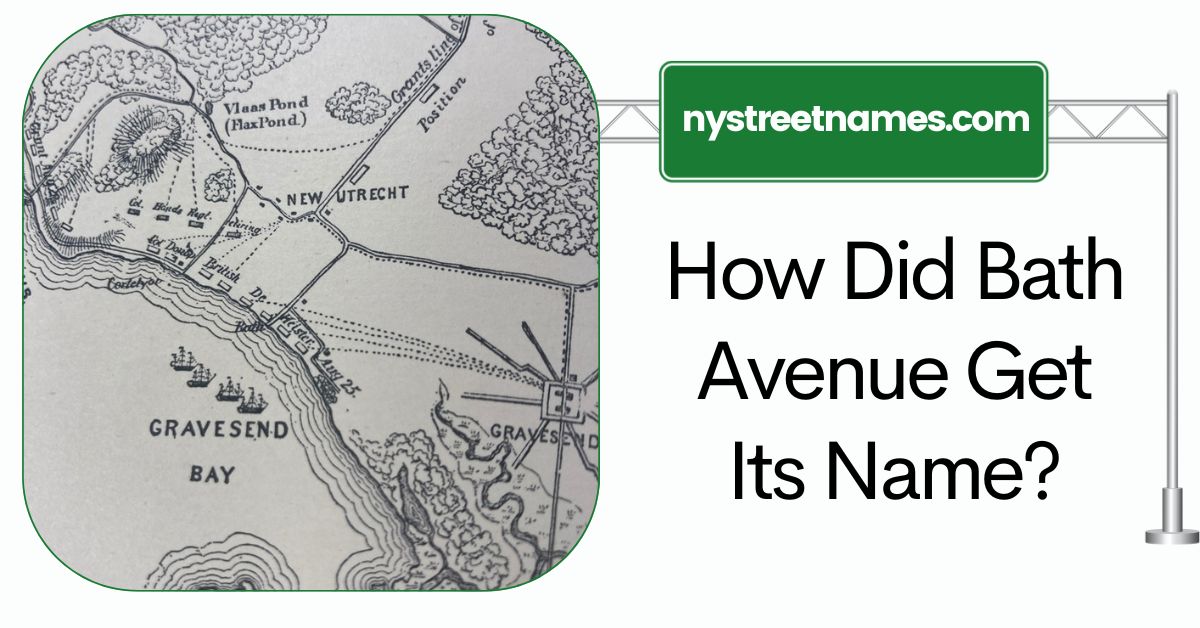Have you wondered how Brooklyn’s Bath Avenue got its name? In this post, learn the answer while you explore the history of this unique NYC community.

You will find Bath Avenue situated on the shores of the Bath Beach neighborhood in Brooklyn. This road stretches just over two miles from Dyker Beach Park to Stillwell Avenue.
Bath Avenue is named after Bath, Brooklyn
As you might have guessed, Bath Avenue got its name from the neighborhood with the same name. This road has been the heart of the neighborhood since the beginning, and was a transportation route to other parts of the borough before the construction of Shore Parkway in the 1940s.
Since it’s easy to understand that the avenue was named after the neighborhood, a curious person might next wonder the etymology of the name for the neighborhood that gave this iconic road its name.
What is Bath in Brooklyn
Bath is a small, relatively quiet Brooklyn neighborhood located south of 86th Street, roughly bordered by the Ft. Hamilton Army Base and Cesar’s Bay. The neighborhood is also known as Bath Beach.
The shoes of the Bath Beach neighborhood are along Gravesend Bay, and there was a very popular beach and resort community located here during the 1800s and early 1900s. Even though an actual beach no longer exists here, the neighborhood has retained the name.

How did the Brooklyn neighborhood Bath Beach get its name?
It is important to know that the area that we now know as Bath was first inhabited by Native Americans. Prior to the arrival of the Europeans, this area was known as Manahanung.
Sometime between the early 1660s and 1776, the area was given the name of “Bath”.
There are a few conflicting theories about the history of Bath in Brooklyn and how the neighborhood got its name. For example, some people say that it is named after Bath, England, while others say that it is a translation of Baden-Baden, a German town.
If we take history into consideration, both explanations make sense. We know that the Dutch were the first Europeans to settle on Long Island, and that the British (i.e. English) were in control of New York, including Brooklyn, by December, 1664.
In the year 1666, the English government declared all of the Dutch land patents invalid and required that new ones be issued. During the process of issuing the new land patents, the town of New Utrecht, which originally included the area that is now known as Bath, was allowed to keep its Dutch name, but it many other nearby Dutch place names were discarded.
It’s possible that Bath was given an English name during this time period.
However, we also might remember that the Dutch were the first European residents of what we now know as New York City. Perhaps some early Dutch settlers were nostalgic about a German town they visited back in Europe?
Alternatively, the name “Bath” might have its origins in a Dutch word, just like Breukelen. In the course of researching for this article, I examined well over one hundred maps of Brooklyn and surrounding areas published between 1600-1800, and I could not find any evidence of a name that the Dutch may have used for this location.
However, the 1639 Manatus map does show that Bath area likely had a Dutch settlement.
Regardless of how exactly the name was given, the area of Brooklyn that we know of as Bath has had this name since at least 1776. The image below was taken from an 1884 book about Kings County, including Brooklyn, and shows Bath clearly marked on the map.

In the map above, there appears to be a short path in the approximate location of the current Bath Ave, but there is no way to tell for sure from the map what the road may have been called at that time, or if it is the same path that is now Bath Avenue.
Conclusion
I hope that this article about one of Brooklyn’s historic neighborhoods, and the street that bears its name, has helped you learn everything that you wanted to know.

Leave a Reply